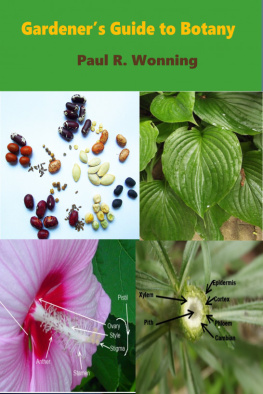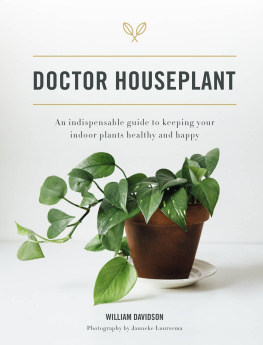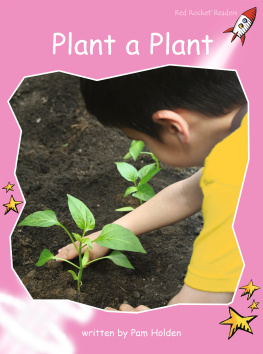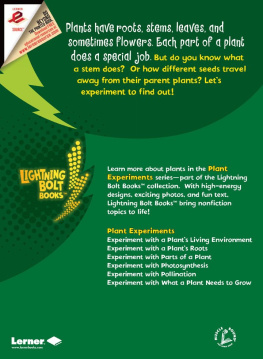Whats Wrong With My Plant?
Whats Wrong With My Plant?
(And How Do I Fix It?)
A Visual Guide to Easy Diagnosis
and Organic Remedies
David Deardorff
and
Kathryn Wadsworth

To Eleanor Summy Deardorff, in memoriam
and
To Ruth Olvey Murphy
We dedicate this book with great love to our mothers,
two wonderful women who taught us to plant seeds,
inspired us to celebrate nature,
encouraged us to explore the wild,
and urged us to follow our dreams.
Copyright 2009 by David Deardorff and Kathryn Wadsworth. All rights reserved.
Illustrations copyright 2009 by David Deardorff. All rights reserved.
Photographs copyright 2009 by David Deardorff and Kathryn Wadsworth. All rights reserved.
Published in 2009 by Timber Press, Inc.
The Haseltine Building | 2 The Quadrant |
133 S.W. Second Avenue, Suite 450 | 135 Salusbury Road |
Portland, Oregon 97204-3527 | London NW6 6RJ |
www.timberpress.com | www.timberpress.co.uk |
Printed in China
Text designed by Susan Applegate
Illustrations produced by Marjorie C. Leggitt
ISBN-13: 978-0-88192-961-4
ISBN-13: 978-1-60469-098-9
Catalog records for this book are available from the Library of Congress and the British Library.
Contents
Acknowledgments
We owe a debt of gratitude to many people for helping us bring this book to fruition. The debt is so great that all should really be at the top of the list. We are amazed by the dedication, diligence, and depth of our editor, Franni Farrell, and greatly appreciate all her help. We are indebted to Regina Ryan, whose professional guidance and patience lit up the path and showed us the way. To the greatest critique group on the planet, Kona Ink, whose membersRebecca Cantrell, Judith Heath, and Karen Hollingerwent above and beyond the call of duty, time and again. Thanks to Elinor Gollay, Rex Brassell, Steve and Louise Carroll, and Meg Elaine Deardorff for providing us with a series of roofs above our heads while we worked. Thanks to Jeanne Huber for striking the match of inspiration in the first place. Many thanks to Mike and Michele Henery and the staff and customers at Henerys Garden Center for helping us refine the questions; and to the Master Gardeners of Washington state for helping us test the diagnostic flow charts. We also owe a great deal to all the loving friends and family members who watered the garden and gave us support every step of the way. We are especially grateful to Barbara Ansley-Vensas, Barbara Smith, Randy Deardorff, Shirley Otis, Michael and Teresa Forrest, and Dave and Anita Weakley. A special thanks to Jake and Annod Bickley for their weekly injection of perspective. Finally, wed like to thank Tom Fischer, Neal Maillet, and everyone at Timber Press whose professionalism and expertise has made this journey joyful and worthwhile.
Introduction
Whether your garden consists of herbs on a kitchen window sill or a densely planted parking strip, a terraced half-acre in Maine or containers on a lanai in Hawaii, it contributes to the well-being of life on earth. Plants are the basic building material for the community of life. All the creatures in our gardens, backyards, balconies, or patios, including us, depend completely on plants because none of us can make energy, we can only consume it.
Those of us who love plants may eventually develop close relationships with them. They have subtle and intriguing ways to communicate with us. Healthy green leaves let us know that the plant is growing well, manufacturing food from the suns energy. Yellowing leaves with dark lesions tell us the plant is in trouble. Flowers that are ragged and full of holes let us know something is eating them. All these symptoms, things you can easily observe with your own eyes without a microscope, are the ways in which a plant communicates its health, happiness, or distress.
Whats wrong with my plant? is the question we hear most from plant owners in distress. This book will help you answer that question, as well as the second most frequently asked question, How do I fix my plantwithout using toxic chemicals? Whats Wrong With My Plant? provides a unique step-by-step method to diagnose and treat diseases, disorders, and pests of the plants entrusted to your care. Be your own plant doctor. No Ph.D. required.
In charts, we present these questions, step by step, to filter all the many possibilities down to only one, the diagnosis (sooty mold, for example).
In .
Using the diagnostic flow charts, you can find out what ails sick plants by observing symptoms. No need to collect bugs or get lost in reference books trying to identify plant species or pathogens. All you need to do is look at the roots, stems, or leaves, note the symptom, and follow the illustrated flow charts to a solution.
To use this book successfully
Above all, do no harm. Before leaping to the conclusion that your plant is dying and then reaching for a toxic chemical to treat it, examine the plant. Whether it is potted up on the sill above your kitchen sink, in a container on the deck, or out in the garden, decide which part of your plant shows symptoms. Then turn to the flow charts in .
PART 1
Whats Wrong?
Easy Diagnosis: The Flow Charts
Why use a diagnostic system?
Most resources on plant problems are difficult to use. Almost all require you to know the name of your plant before you can proceed. But what if you inherited the garden or received the plant as a gift, and you have no handy map or label? In some resources you can page through photographs hoping to find a picture that matches the problem you see. But, what if you cant find a match? What do you do now?
This book is different. It presents a diagnostic system with easy-to-use flow charts. The diagnostic flow charts consist of a series of simple questions, presented in pairs. Each pair is illustrated. Each question can be answered yes or no. By observing symptoms on your plant and answering the questions, you can follow the flow charts to a diagnosis. The diagnosis gives you the cause of the problem.
How do I use the flow charts?
1. Whether your plant is indoors or outside, be sure to examine it carefully. If you find more than one symptom, even if you are beset with problems, concentrate on one. It is important to pursue just one symptom at a time. Turn to the table of contents to decide whether it is the whole plant or a specific plant part that exhibits a symptom.
2. Turn to the chapter about the plant part with the symptom. Look at each illustration and read the text beside it. Find the plant symptom that most closely matches yours and decide in which category of the flow charts your plant belongs.
3. Turn to the page indicated for that category of the flow chartsyour tool for pinpointing the problem.
WARNING: It is sometimes tempting to try to match your plant to an illustration without reading the accompanying text. However, it is important to consider the questions. Simply visually matching your plant to a drawing may lead to the wrong diagnosis.
4. Each flow chart poses a series of paired questions (couplets) about a symptom. Answer the questions yes or no. Only one member of each pair of questions can be answered yes.
Next page








